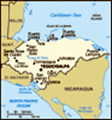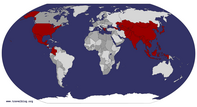Advertisement
Published: September 18th 2018
Getting into Honduras was complicated by the immigration staff on the El Salvadoran side who had neglected to stamp us in or out of the country. This completely flummoxed the man on the Guatemalan side of the border who wanted to know where we’d been for the previous 3 weeks; eventually, we managed to convince him that we weren’t a threat to national security and were allowed to proceed onwards to the town of Copan.
Famous for its coffee production – the best we have tasted on our travels to date - Copan is a nice, relaxed town; a welcome change of pace to the frenzied atmosphere in most places we have been to lately.
We booked onto a Horseback riding tour and dragged along Joppe, a Dutch lad we met in Juayua; he comes from Rotterdam and supports Ajax which is the equivalent of a scouser supporting United. He’s about 6 foot 6, and his horse looked like it was buckling at the knees whenever it had to pull his giant frame uphill. Mine was a bit of a character and kept walking me into as many low hanging tree branches as possible.
Our guide was 72
but didn’t look anywhere near that age, he had more energy than all three of us combined and took us up into the hills to a hacienda where he had worked his entire life. While we were there, we overheard a group of English tourists talking about their experience of going into a pub in Eccles of all places - it was clearly a massive culture shock to these sensitive souls who described the incident as ‘scary’.
In the town of Copan, we discovered Baleadas for the first time. The traditional Honduran snack consists of a folded tortilla with a choice of fillings like beans, cheese, chorizo or chicken. Averaging a $1 each, they became a big part of our diet during our time in the country; similar to the role Pupusas played in El Salvador.
Our trip from Copan to La Ceiba was chaotic which seems to be the norm by now. We had been informed by a range of people that the road to San Pedro Sula was plagued by roadworks and other issues at present and that travelling time could be double what we had expected. We took this information on board and booked the
earliest bus possible as we had to make the last ferry across to Utila at 4 pm. Apologising profusely after arriving half an hour late, our driver then reasoned that he had time to drive around town giving a jump start to numerous locals before finally getting on the road. Accompanying us on the drive were two parrots in huge cages, bound for the island of Roatan and, for the next 6 hours, we were subjected to their non-stop squawking.
Four stops and an unexplained change of vehicles and driver later, our infuriatingly relaxed man at the wheel finally responded to our questions regarding our arrival time. He casually informed us that we wouldn’t be there at 4 pm. Sensing our ‘disappointment’, he then made a phone call to his sister who we were assured had a fast car. It wasn’t fast at all, nor did it have door handles, and Joppe, our Dutch companion forced himself through a window to let us in. It wasn’t a well thought out plan in any way though, and the huge cages containing the parrots – clearly more valued customers – had to be accommodated. One was given the front seat, and
the second was shoved onto our laps in the back seats. So we spent the remainder of the journey forced to sit with our heads pinned back against the headrest in order to keep out of the reach of the parrot’s claws and beak that were protruding through the bars, inches away from our faces. We arrived at the dock with minutes to spare and boarded the ferry across to the island of Utila. The boat has the nickname of the ‘Vomit Comet’, and the reason for this became apparent very quickly as the crew came around giving out sick bags out within 10 minutes of departure.
Despite visiting countries where scuba diving was one of the main attractions, we had never really been interested in giving it a go prior to this trip. After hearing such glowing accounts of the diving conditions on the bay islands, one of which being the price, we decided to try it out finally. One drawback was that Melissa doesn't like the idea of being responsible for her own safety - God knows how she's managed to survive the previous 39 years. We signed up for the PADI Open water course with Alton’s
dive shop and were introduced to Gaby, our instructor from the famous diving mecca of Switzerland. The introduction to the course was a four-hour instructional video in a classroom followed by a confined water course where we familiarised ourselves with the equipment and safety techniques.
The unnatural feeling of breathing underwater took some getting used to and the exercises we had perform were a bit challenging at first, they included taking off equipment underwater, clearing a mask, a 200m swim and breathing from a free-flowing regulator. The first descent was the most uncomfortable, remembering all the drills while maintaining equalisation was difficult initially, but by the second time the second dive came around, we had got the hang of it.
During one exercise, Gaby turned off our oxygen in order for us to experience the feeling of running out of air. Melissa later admitted that when she was asked how much oxygen her gauge was reading, she just made it up which isn’t the thing you want to be nonchalant about really. I had to rely on her to provide me with emergency air supply in one nerve-wracking ‘buddy’ exercise. I was hoping to be paired with a
different buddy - anybody else at all – but she did alright, I survived. Although later, she did manage to pull the respirator out of my mouth as she swam by; even underwater with the entire Caribbean Sea at her disposal, she manages to be clumsy. Either that or she's trying to kill me.
On our last day on Utila, we took a boat across to Water Caye with an Irish lad we had met. For $15, we got a boat and captain and were delivered to an uninhabited island for the day, where we spent an afternoon on the paradise island with a cooler full of beer. That was a good day.
After being deemed competent enough to keep ourselves alive by PADI, we decided to venture further across the Caribbean Sea to the outlying island of Roatan to consolidate what we had learnt on the open water course. Melissa’s friend Meg is an instructor on there, and we had planned to dive with her company. Although Utila was brilliant, the reef in Roatan was something special; we did a couple of dives along west bay amongst a wide variety of marine life and swam alongside a
turtle as it munched away on the coral.
Roatan welcomes cruise ships on a weekly basis, a time where 5,000 people descend on the island. Thankfully, our visit didn’t coincide with one but the prices – all displayed in US dollars once more – were still double that of Utila. One shop was asking for $23 for either Hawaiian Tropic or something called Ocean potion, which sounded more like a chemistry experiment than a skincare product.
After making our way back to the mainland courtesy of an upgraded version of the Vomit Comet, we made our way from the ferry terminal at La Ceiba to the Pico Bonito National Park where we had planned to arrange a white water rafting trip on the nearby Rio Cangrejal. We arrived at our accommodation a Jungle Lodge that was, as advertised, located in the middle of the jungle. Underwhelmed would probably be the best description of our reaction to what we were confronted with. It was like we had arrived at Camp Crystal Lake, there seemed to be only one member of staff and we were the only guests. There was also a massive thunderstorm that night, just to make things
more atmospheric.
Our rafting experience the following day was fantastic though; it was booked through our lodge, which was the cheapest in the area by far and it was clear to see why. Our guide was apparently discontent with the conditions on the river and decided to turn up the extreme-ratings a notch by making us get out of the raft and climb up and over a bank of rocks before jumping back into the raft and launching ourselves off into the river below. There were other groups on the river who evidently had more cautious/ professional staff, and they avoided certain sections of the river. Not us though, we were told that we had a different type of raft that could navigate these more hazardous elements; we paid a third of what other companies were charging, but we got an extended trip, more rapids, and a guide who was on a personal crusade to provide exceptional value for money.
Our next destination in Honduras was the D&D Brewery at Lake Yajoa, which was an awkward location to get to from La Ceiba. It had been made abundantly clear to me that it was solely my decision for
us to include D&D in this part of the trip; therefore, any blame for a poor choice would rest squarely on my shoulders. So it was a relief to discover that the brewery was a bit of an oasis in the area, I was also thankful for the Saturday night special of rum and lemonade which no doubt saved me some serious earache. Situated in the countryside with an ecological and archaeological site nearby and within a short distance to Lake Yojoa, the main activity here was hiring a kayak around the nearby canal and lake. We chose a double, and quickly established that it was far easier if just one of us did all the work as synchronised rowing was not going well. No prizes for guessing who landed that job as Her Majesty sat at the front taking in the views.
All bus travel in Honduras necessitates transiting through the much-maligned city of San Pedro Sula where the main bus terminal resembled a fortress. After leaving the lake, we took a bus north through SPS as it's known, before connecting to another local bus back to where we started out - the border town of Copan. After
an overnight stay in a weird room that offered an open plan bedroom/shower/toilet/kitchen combo, we took a shuttle back over the border to Guatemala City. We had managed to avoid the capital city of Guatemala up to this point, and we stayed just one night at a hostel near to the airport before catching an early morning flight to San Jose as a result of having to skip over the now inaccessible Nicaragua.
Advertisement
Tot: 0.296s; Tpl: 0.016s; cc: 10; qc: 51; dbt: 0.0475s; 1; m:domysql w:travelblog (10.17.0.13); sld: 1;
; mem: 1.2mb


















